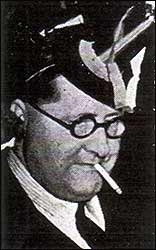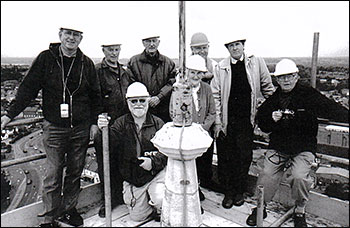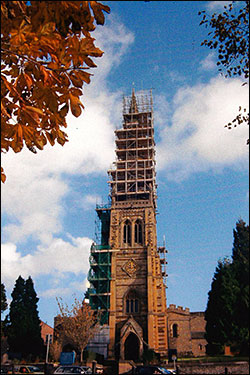The Wellingborough News, 4th July 1885, transcribed by Gill Hollis
The Restoration of The Church Spire
The following are the tenders received for the restoration of Rushden church spire, in accordance with the forms of the specification set forth by Mr. W. L. Baker, of London, after a careful inspection of the structure:- Mr. J. Till (Nottingham), £625; Mr. E. Brown (Wellingborough), £285; Mr. J. T. Wingrove, Northampton, £247 10s; Mr. W. Streather, Raunds, £225; Mr. Joseph Blackburn, Nottingham, £164 15s 6d; Mr. Blackburn’s tender has, we understand been accepted, and the work will be put in hand immediately. It appears from an inscription cut upon the doorway leading from the tower to the battlements that the spire has not been pointed since 1719. We understand that it has been decided to hold a bazaar in the Rectory Grounds of a specially attractive character, in order to raise a portion of the funds required for the necessary work, and we have no doubt but that all inhabitants of Rushden will co-operate heartily in the work of preserving their beautiful church spire, which is said to be unsurpassed in gracefulness and perfectness of proportion even in this county of fine spires.
|
| 27 June 1902 - Northampton Mercury
EXCITING INCIDENT AT RUSHDEN. About eight o'clock on Monday evening the residents of the town, or, at least, several hundreds of them, witnessed a foolish, but, at the same time, daring, adventure on the part of a man named Ingram, who was observed to be ascending the scaffolding which is erected round the church spire for repairs. Having reached the base of the steeple, Ingram was seen to commence climbing up by means of the stone abutment, which runs to within 10 or 12 feet of the weather vane. Reaching the highest ledge, Ingram encircled the tapering steeple with his arms and legs, and climbed to the top stone on which he sat apparently very cool and collected. He then amused the spectators by turning the weathercock round, and finished up by taking out of his pocket a red, white, and blue flag which he secured to the top of the vane. Ingram then descended in the same manner that he went up, and at once proceeded to take his hat round and obtained a good collection. The end of the surprises, however, had not yet been reached, for instead of pocketing the spoils Ingram distributed the contents of the hat among the children assembled round the church. The flag is still flying on the steeple.
|
Rushden Echo, 13th September 1918, transcribed by Kay Collins
Church Spire—The repair of the church spire has been commenced this week, and ladders have been affixed. The work is being carried out under the direction of Mr. A. H. Bowen, of Edmonton, and an ascent of the spire revealed that the damage is more extensive than had been anticipated, the masonry in all probability having been struck by lightning. It will probably be some two or three weeks before the work is completed. In addition to the work on the masonry, a new lightning conductor will have to be fixed, and the total cost is estimated at over £100, and we hope a liberal response will be made to the Rector’s appeal for a good collection on Feast Sunday. Our beautiful church spire—perhaps the most beautiful in this county of beautiful spires—is a precious possession to the town of Rushden, and its good repair may well be thought to concern the whole town. The Rector will be glad to receive donations from any friends interested in the preservation of the church spire, irrespective of creed or denomination. The various dates of the restoration of the spire are marked on the masonry, the earliest being 1498 A.D. Intervals of a century of the following restorations are as follow: 1620, 1719, 1885, and 1918. The probably date of the erection of the spire would be about A.D. 1400.
|
|
Splash Magazine, Summer 1953 p8
When They Measured Church Spire with String
|
String for sale; enormous quantities; highest reference. Apply Telegraph Office, Rushden.
|
PERHAPS you don't believe this small ad. has ever been published. It hasn't, but it could have been.
 |
|
Steeple Researcher Elliott in Celebration Steeple Hat
|
You have a parcel to tie? A hundred parcels? Or you just want to pull a string? Ring Rushden on the intercom, and we will meet your every need.
Now of all places on this terrestrial ball Rushden office has long been the most stringless. To tie a parcel meant shredding a piece of publisher's rope, or sacrificing one's braces, or searching for a multi-knotted scrap of string saved up from the last incoming package.
So why the sudden abundance? Why the bulging drawers, the stacked-up basement, the trailing lines that snake and trip the unwary? We will tell you. . . .
One day in April there was rather a mad sort of scene. "Don," boomed a voice, "go and buy some string—lots of it; not less than two hundred feet. Take it to so-and-so, do so-and-so, and fail at your peril." (Exit Don).
Skipping Scene 2, we now describe Scene 3—a room at the office where string is being unwound from a stick and measured against the edge of a table. Weary arms are stretched like those of a particularly imaginative angler. Somebody counts aloud, and a female, gladly forsaking "Coronation Background No. 33," writes down some figures.
Presently the tension is unbearable. Will it never end? It will and does. Figures are added up. Groans rend the air. A story is written. . . .
We said it was rather mad, didn't we?
Well, now for Scene 2. Don makes cautious approach to St. Mary's Church, whistles for the steeplejacks to come down from the clouds, and hands them seven shillings worth of best string. "Take this," he says, "and dangle it from the highest point. The Echo and Argus and Evening Telegraph wish to check-up on the height of the steeple."
Steeplejacks will do anything for an occasional photo of themselves, and in a few minutes our plumb line, weighted with metal, was being lowered from a plank in line with a lineal.
When the weight touched the tower roof the spare string in the clouds was cut off. Then from the battlements the tower was measured by the same method. The string, already cut to the exact length of the spire, revealed the tower to be somewhat shorter, so a knot was tied where the surplus began. . . .
And the story? It said that the height of Rushden's beautiful spire, always believed to be 192 feet, was only 164 feet. A local expert challenged the old figure in 1946 and we had waited for the chance to prove him right or wrong. Just before the string test the local surveyor—also at our request—had made a survey by theodolite. The string confirmed his report, and that was that.
Finally, a confession. We bought two lots of string to get the low-down on the church, but one was never used. It did not occur to us that tower and spire could be measured separately.
|
|
The Rushden Echo and Argus, 14th January 1955, transcribed by Gill Hollis
A ball of string measured spire
One day a historical Sherlock Holmes will find out the identity of the hoaxer who misled Northamptonshire for more than a century about the height of Rushden spire.
For years it was credited with 192 feet – twelve feet higher than Kettering and 17 above Higham.
Even that final authority on matters of fact the Victoria County History plumped for 192.
Then in his book on church spires, Mr. L. G. H. Lee cast doubts on the figure “Nearer 160 feet.” He said.
PIECE OF STRING
And finally when steeplejacks were up aloft, colleague L. V. Elliott of our Rushden office had the height measured – with a piece of string.
Sure enough it was 164 feet, and Mr. Elliott has preserved the string in his office to confound doubting Thomases.
But who made the initial mistake? I have traced it back to 1849, when Whellan’s Directory gave 192 feet.
The writer on Rushden was in a happy-go-lucky mood for he gaily confused Rushden with Rushton, 14 miles away, and described the church as possessing both “a spire” and “a steeple.”
|
Rushden Echo & Argus, 3rd April 1953, transcribed by Kay Collins
TAKEN down from its lofty perch when restoration work began, the weathercock of St. Mary's, Rushden, had long been supposed to reside at a height of 192 feet above ground.
It returned to Rushden in the splendour of new gilt, only to find that the spire had been measured and was no more than 164 feet. Mr. G. E. V. Fleeman, a churchwarden, fondled the bird consolingly on Wednesday afternoon, and the steeplejacks will take it aloft in a few days.
In the meantime the weathercock, with four small turret vanes of similar design, can be inspected at the Vestry Hall. It bears the inscription: "Blackburn, Nottingham, 1885. Repd. by Furse Nottm., 1953."
|
2002 Restoration
 |
Back L to R: Bob Whitworth, John Wreford (contractor),
David Clarke, Mick Bantin, John Barker (architect)
Front L to R: Alan Marks, Meg Boatright, Peter White”
Photo by Glyn Muncey
|
|
|
 |
|
Photo by Greville Watson, 2002
|
|
|
Eric Fowell said: "Back in 1953, St. Mary’s Church had major restoration involving 23 feet of the spire being demolished and then rebuilt, the top 12 feet being of solid stone. An accurate measure of the height of the spire showed it to be, to the surprise of Rushden townsfolk, 172 feet and not 192 feet. The measurement was made by Mr Leslie Priestly. At the time the contractor was Messrs Fuze of Nottingham.
This year, 2002, we have seen our church again undergo major work costing well over £100,000. A party of nine people mounted the scaffolding to the very top, where Glyn Muncey took a unique photo of the group at the peak of the spire. Within the party was the consultant John Barker, from the architects Gotch Pearson of Wellingborough, and John Wreford, foreman in charge from Underwood Weston Builders of Northampton, the contractors for this restoration work.
During the severe gales of Sunday, October 27th 2002, a very large crack appeared in the spire again causing further delays in completing the work."
|
|
|